From ‘big’ hair and colour in the 80s to more ‘natural’ looks and ingredients in the 2020s, health and beauty trends are constantly evolving. Just like buying a serum to give your skin a lift, healthy and beauty brands can give their online marketplaces sales a lift by keeping tabs with the latest trends.
As we enter the final half of the year, here’s our five to track for 2024.
Greater ‘medicalisation’
Be it anti-ageing creams or slimming shakes, the health and beauty industry has long espoused the scientific benefits of its products (often through ‘white lab coat’ marketing), but now consumers want more proof than a shiny advert. In fact, a 2023 Mintel Report found that three-quarters of Spanish beauty buyers think brands should give more scientific evidence about the claims of their products.
This ‘medicalisation’ of beauty will not only impact how products are marketed, but also the consumer scrutiny of the ingredients used. Given ingredients are now easily researched on the internet, consumers are more likely to research their effectiveness online before making a purchase and are also expected to ditch highly-chemical or synthetic products (i.e. those with lead or cadmium) for those enriched with vitamins, natural oils and organic extracts.
More sustainable products
It’s not just about the health benefits of natural ingredients, but their environmental impact too. Consumers are increasingly looking for more sustainable health and beauty products, such as single ingredient products (i.e. 100% Argan oil) with lower carbon footprints. Brands that have replaced chemical substances with bio-based ones or ‘upcycled’ ingredients (i.e. transforming a previously discarded or waste product into a key usable ingredient) will stand in good stead.
Sustainability trends also extend from what’s inside the bottle to what’s on the outside. Recyclable or biodegradable packaging (i.e. beeswax or mushroom packaging) are expected to rise in popularity, as well as products with greener supply chains (i.e. locally-sourced ingredients, locally-packaged products and delivered sustainably). In 2024, lipgloss won’t just be about the sheen, but also the ‘green’.
More customised healthcare
Cosmetics matched to your genetics? Customised healthcare used to be the preserve of the super-rich (i.e. bespoke crafted luxury fragrances), but is fast-becoming a mass-market reality thanks to advances in diagnostics (i.e. the proliferation of wearable devices that track personal health) combined with advances in synthetic biology technologies.
Up to now, ‘custom’ has been limited to a range of skin tones and ages, but soon customers could access foundations based on their hormones or hair care products suited to dryness and thinning, as well as specialised vitamin routines and supplements. Customisation will also extend to personalised packaging (i.e. with names and messages tailored to the buyer). As tech continues to advance, expect to see more personalised options available (and affordable) next year.
Increased diversity
Consumers want beauty to be more inclusive. In recent years, the health and beauty industry has tried to shed its generic and homogenous concept of beauty - i.e. using more plus-size models in lieu of ‘impossibly-shaped’ models - but there is still a way to go. In fact, 72% of US beauty buyers think society’s idea of beauty is still too rigid and want to see more representation, body positivity and products marketed to those with mobility challenges.
Ultimately, health and beauty is about making yourself feel good and should be available to everyone no matter their shape, shade or age. Expect to see more inclusive and diverse beauty products and marketing in 2024.
Greater premiumisation
As we’ve seen in fashion, current economic uncertainty has not dampened the demand for affordable luxury. The same is true for health and beauty products. Even as supply chain and inflation issues increase the cost of ingredients, packaging and the final product, buyers are still looking for luxury at reasonable prices, but are becoming more selective with their choices. In skin care, for example, consumers may purchase one premium product which covers multiple skin benefits instead of multiple products with specific functions.
The Lipstick Index - a theory that cosmetic sales increase during economic downturns as customers look for relatively inexpensive ways to treat themselves (i.e. luxury skin cream is more affordable than a luxury handbag) - bodes well for premium products in 2024.
Stay on trend
Whether you sell beauty cosmetics or body care products, keeping tabs with the latest trends is essential to boosting online marketplaces sales. Find out more by reaching out to Rich Insight.






Blog Comments